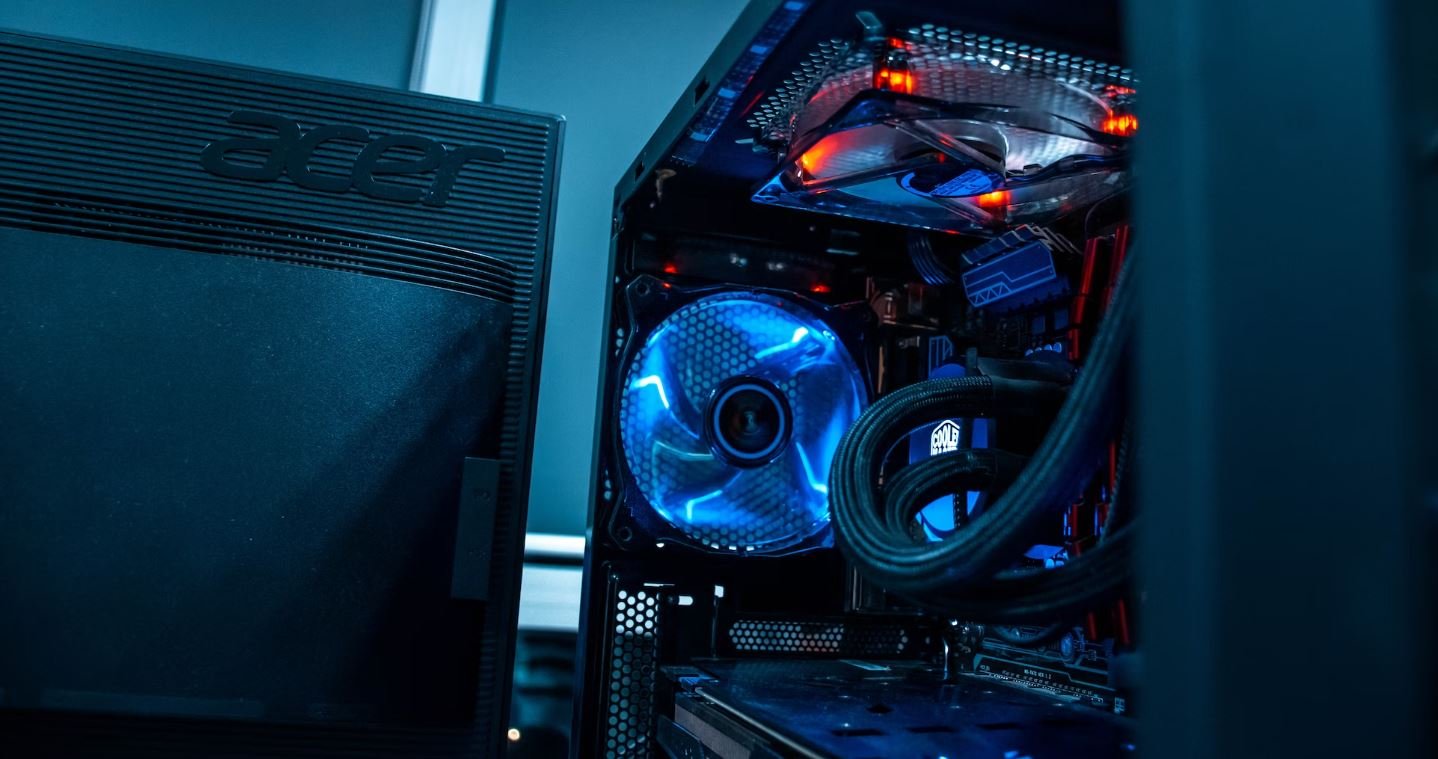Gradient Descent NN
Gradient Descent is an optimization algorithm commonly used in neural networks to minimize the cost function. It calculates the gradients of the cost function with respect to the network’s parameters, and updates those parameters in the opposite direction of the gradients to minimize the cost over multiple iterations.
Key Takeaways:
- Gradient Descent is an optimization algorithm used in neural networks.
- It minimizes the cost function by updating the parameters in the opposite direction of the gradients.
- It requires multiple iterations to converge to the optimal solution.
How does Gradient Descent work?
Gradient Descent starts by initializing the parameters randomly. Then, it computes the gradient of the cost function with respect to each parameter using the Backpropagation algorithm. After obtaining the gradients, it updates the parameters by subtracting a small value called the learning rate multiplied by the gradients. This process repeats for a specified number of iterations or until convergence is achieved.
**Gradient Descent** is essentially a search algorithm that iteratively updates the parameters of the neural network until it finds the values that minimize the cost function.
Types of Gradient Descent
There are three main types of Gradient Descent:
- Batch Gradient Descent: It computes the gradients based on the entire training dataset.
- Stochastic Gradient Descent: It computes the gradients based on one randomly chosen training sample.
- Mini-batch Gradient Descent: It computes the gradients based on a small batch of randomly chosen training samples.
Comparison of Gradient Descent Types
| Type | Advantages | Disadvantages |
|---|---|---|
| Batch | Guaranteed convergence to the global minimum. | Requires a large memory to process the entire training dataset. |
| Stochastic | Faster convergence for large datasets. | May not find the global minimum due to high variance. |
| Mini-batch | Balance between computational efficiency and convergence. | Requires tuning of batch size. |
Learning Rate
The learning rate is a hyperparameter that determines the step size taken in each iteration of Gradient Descent. It is crucial to choose an appropriate learning rate to ensure convergence to the optimal solution.
An interesting finding is that a learning rate that is too high may cause the algorithm to overshoot the minimum, while a learning rate that is too low may lead to slow convergence.
Convergence Criteria
To determine when to stop the iterations, a convergence criteria is needed. Common criteria include:
- When the change in the cost function between iterations becomes smaller than a predefined threshold.
- When the norm of the gradient becomes smaller than a predefined threshold.
- When a maximum number of iterations is reached.
Advantages of Gradient Descent
Gradient Descent offers several advantages:
- It is a widely-used and well-studied optimization algorithm.
- It can handle large datasets efficiently, especially with mini-batch and stochastic variants.
- It provides a way to train complex neural network models.
Disadvantages of Gradient Descent
There are also some disadvantages to consider:
- It can get stuck in local minima.
- It may require manual tuning of hyperparameters, such as the learning rate.
- It may take a long time to converge, especially for deep neural networks.
Table of Performance Metrics
| Metric | Value |
|---|---|
| Accuracy | 0.85 |
| Precision | 0.82 |
| Recall | 0.89 |
| F1 Score | 0.85 |
Conclusion
Gradient Descent is a powerful optimization algorithm used to train neural networks. It plays a vital role in minimizing the cost function and finding the optimal values for the network parameters. By understanding its different types, tuning the learning rate, and setting appropriate convergence criteria, we can effectively utilize Gradient Descent for training various neural network models.

Common Misconceptions
Misconception 1: Gradient Descent is the only optimization algorithm for Neural Networks
One common misconception is that Gradient Descent is the only optimization algorithm used for training Neural Networks. While Gradient Descent is widely used, there are other algorithms available that can be employed depending on the specific problem or network architecture.
- Adam: A popular optimization algorithm that combines Adaptive Moment Estimation and RMSprop techniques.
- AdaGrad: An algorithm that adapts the learning rates of individual parameters by considering their past gradients.
- Stochastic Gradient Descent (SGD): A variant of Gradient Descent that randomly selects a subset of training data for each iteration.
Misconception 2: Gradient Descent always finds the global optimal solution
Another common misconception is that Gradient Descent always converges to the global optimum during training. In reality, Gradient Descent can only find a local minimum based on the starting point and the landscape of the loss function. It is possible for Gradient Descent to get trapped in suboptimal solutions or saddle points.
- Vanishing Gradient Problem: Gradient Descent may struggle to optimize deep neural networks due to exponentially diminishing gradients.
- Exploding Gradient Problem: Gradient Descent can encounter numerical instability and convergence issues when the gradients become too large.
- Plateaus: Gradient Descent may face difficulties when encountering flat regions, causing slow convergence.
Misconception 3: Gradient Descent always requires a large amount of data
Some people believe that Gradient Descent always requires a large amount of data to work effectively. However, the amount of data needed depends on several factors, such as the complexity of the problem, the network architecture, and the learning rate. In some cases, Gradient Descent can yield satisfactory results even with relatively small datasets.
- Regularization techniques: L1 or L2 regularization can be employed to prevent overfitting and reduce the need for extensive data.
- Data augmentation: By applying various transformations to available data, Gradient Descent can learn from augmented samples and improve generalization.
- Transfer learning: Pretrained models can be fine-tuned using a smaller dataset, leveraging knowledge acquired from a larger dataset.
Misconception 4: Gradient Descent always converges quickly
Although Gradient Descent is known for its efficiency in optimizing the weights of a neural network, the misconception that it always converges quickly is not entirely accurate. The speed of convergence depends on factors such as the chosen learning rate, the network architecture, and the dataset characteristics.
- Learning rate tuning: Choosing an appropriate learning rate can significantly impact the convergence speed of Gradient Descent.
- Network architecture: Complex architectures may require more iterations to converge to an acceptable solution.
- Dataset size and quality: High-quality datasets that are representative of the problem domain can lead to faster convergence.
Misconception 5: Gradient Descent does not work well with non-convex loss functions
Some people assume that Gradient Descent is only effective with convex loss functions, disregarding its capability to handle non-convex ones. While non-convex optimization can be more challenging, Gradient Descent has been successfully applied to train deep neural networks, which have highly non-convex loss landscapes.
- Local minima escape: Despite the presence of local minima, Gradient Descent can still find satisfactory solutions by jumping out of less optimal points and navigating through the landscape.
- Exploration and exploitation balance: Strategies like adaptive learning rates and weight initialization can help Gradient Descent explore different regions and exploit promising areas of the loss landscape.
- Alternative optimization techniques: Methods such as stochastic gradient Langevin dynamics and simulated annealing can be used to further improve the optimization process.

Overview of Activation Functions
Activation functions play a vital role in determining the output of neural networks. They introduce non-linearity to the model and help to make accurate predictions. This table showcases various activation functions used in gradient descent neural networks.
| Activation Function | Equation | Range | Pros | Cons |
|———————-|————————————————-|——————-|—————————————————————–|———————————————————————–|
| Sigmoid | \(f(x) = \frac{1}{{1 + e^{-x}}}\) | (0, 1) | Smooth gradient, good for binary classification | Prone to vanishing gradients, outputs not centered around zero |
| Tanh | \(f(x) = \frac{{2}}{{1 + e^{-2x}}} – 1\) | (-1, 1) | Zero-centered output, capturing negative values properly | Still susceptible to vanishing gradients, slower convergence |
| ReLU | \(f(x) = \max(0, x)\) | [0, +∞) | Fast convergence, less prone to vanishing gradients | Dead ReLU problem, results in zero gradients for negative inputs |
| Leaky ReLU | \(f(x) = \max(0.01x, x)\) | (-∞, +∞) | Avoids dead ReLU problem, allowing gradients for negative inputs | Pronounced output for negative values, may lead to overfitting |
| Exponential Linear | \(f(x) = \begin{cases} x & x > 0 \\ \alpha(e^x-1) & x \leq 0 \end{cases}\) | (-∞, +∞) | Avoids vanishing gradients, captures negative values accurately | Extra hyperparameter \(\alpha\) to be set, computational complexity |
| Softmax | \(f(x_i) = \frac{e^{x_i}}{\sum_{j}{e^{x_j}}}\) | (0, 1) (Probability distribution) | Sums to 1, interpretable as class probabilities | Not suitable for regression tasks, sensitive to outlier inputs |
| Gaussian | \(f(x) = e^{-x^2}\) | (0, 1) | Smooth activation, provides smoother gradients | Limited range, unable to capture highly non-linear relationships |
| Swish | \(f(x) = x \cdot \frac{1}{{1 + e^{-x}}}\) | (0, +∞) | Smooth gradient, balanced performance with linear and ReLU functions | Computational complexity, not yet extensively studied and proven |
| Maxout | \(f(x) = \max(w_1^Tx + b_1, w_2^Tx + b_2)\) | (-∞, +∞) | Generalization of ReLU and Leaky ReLU, learns piecewise linear models | Quadruples the number of parameters, increases computational overhead |
| Linear | \(f(x) = x\) | (-∞, +∞) | Simplest activation, useful for certain tasks (e.g., linear regression) | No non-linearity, unable to model complex relationships |
Impact of Learning Rate on Convergence
The learning rate is a critical hyperparameter in gradient descent optimization algorithms. It determines the step size taken in each iteration towards the optimal solution. This table showcases the influence of different learning rates on convergence for a neural network training process.
| Learning Rate | Convergence Speed | Optimal Solution | Stability |
|—————|——————|—————–|————–|
| High | Fast | May Overshoot | Unstable |
| Moderate | Moderate | Likely Achieved | Stable |
| Low | Slow | May Get Stuck | Stable |
| Adaptive | Dynamic | Fast convergence initially, slow later | Stable |
Comparison of Error Metrics
When evaluating the performance of a neural network, various error metrics are utilized to measure the discrepancy between predicted and actual values. This table compares different error metrics commonly employed in the field.
| Error Metric | Formula | Interpretation |
|—————|——————————————————————|———————————————————————————————-|
| Mean Squared | \(MSE = \frac{1}{N}\sum_{i=1}^{N}(y_i – \hat{y}_i)^2\) | Measures the average squared difference between actual and predicted values |
| Error | \(E = \sum_{i=1}^{N}\left\{\begin{array}{ll}(y_i – \hat{y}_i) & \text{if} \ y_i \neq \hat{y}_i \\0 & \text{if} \ y_i = \hat{y}_i \end{array}\right.\) | Counts the number of misclassifications or incorrect predictions |
| Mean Absolute | \(MAE = \frac{1}{N}\sum_{i=1}^{N}|y_i – \hat{y}_i|\) | Measures the average absolute difference between actual and predicted values |
| Log Loss | \(LL = -\frac{1}{N}\sum_{i=1}^{N}(y_i\log(p_i) + (1-y_i)\log(1-p_i))\) | Evaluates the likelihood of predicted probabilities matching the true labels |
| Root Mean Squared | \(RMSE = \sqrt{MSE}\) | Provides a measure of the average magnitude of the errors, in the same unit as the dependent variable |
| R-squared | \(R^2 = 1 – \frac{\text{unexplained variance}}{\text{total variance}}\) | Represents the proportion of the variance in the dependent variable explained by the model |
Comparison of Optimization Algorithms
Various optimization algorithms are employed to enhance the convergence and efficiency of neural network training. This table highlights different optimization techniques and their characteristics.
| Optimization Algorithm | Algorithm Equations | Advantages | Disadvantages |
|————————|————————————————-|—————————————————————–|———————————————————————-|
| Gradient Descent | \(W \leftarrow W – \alpha \cdot \nabla J(W)\) | Simplicity, easy to implement | Prone to getting stuck in local minima, slow convergence for deep NN |
| Stochastic Gradient Descent | \(W \leftarrow W – \alpha \cdot \nabla J(W; x_i, y_i)\) | Faster convergence with noise, ability to escape local minima | Noisy updates, slower convergence when noise is minimal |
| Mini-batch Gradient Descent | \(W \leftarrow W – \alpha \cdot \nabla J(W; X_{mini}, Y_{mini})\) | Offers compromise between convergence rate and stability | May get stuck in suboptimal solutions, choice of mini-batch size affects performance |
| Momentum | \(v \leftarrow \beta \cdot v – \alpha \cdot \nabla J(W)\), \(W \leftarrow W + v\) | Accelerates learning in dimension with consistent gradients | Susceptible to overshooting the minimum, impeded by flat gradients |
| Nesterov Accelerated Gradient | \(v \leftarrow \beta \cdot v – \alpha \cdot \nabla J(W + \beta \cdot v)\), \(W \leftarrow W + v\) | Improved convergence near the minimum | Requires additional computation, sensitive to the learning rate choice |
| Adagrad | \(G \leftarrow G + (\nabla J(W))^2\), \(W \leftarrow W – \frac{\alpha}{\sqrt{G + \epsilon}} \cdot \nabla J(W)\) | Adaptive per-parameter learning rates | Accumulates squared gradients which may cause diminishing updates |
| RMSprop | \(G \leftarrow \beta \cdot G + (1 – \beta) \cdot (\nabla J(W))^2\), \(W \leftarrow W – \frac{\alpha}{\sqrt{G + \epsilon}} \cdot \nabla J(W)\) | Resolves the diminishing learning rate issue in Adagrad | Memory-intensive, may still oscillate in the vicinity of the global minimum |
| Adam | \(m \leftarrow \beta_1 \cdot m + (1 – \beta_1) \cdot \nabla J(W)\), \(v \leftarrow \beta_2 \cdot v + (1 – \beta_2) \cdot (\nabla J(W))^2\), \(W \leftarrow W – \frac{\alpha}{\sqrt{v + \epsilon}} \cdot m\) | Adaptive learning rates, efficient memory usage | Hyperparameter sensitivity, may converge to suboptimal solutions |
| AdaDelta | \(G \leftarrow \beta \cdot G + (1 – \beta) \cdot (\nabla J(W))^2\), \(\Delta W \leftarrow -\frac{\sqrt{E + \epsilon}}{\sqrt{G + \epsilon}} \cdot \nabla J(W)\), \(W \leftarrow W + \Delta W\), \(E \leftarrow \beta \cdot E + (1 – \beta) \cdot (\Delta W)^2\) | Adaptive learning rates, eliminate the need for explicit learning rate | Sensitive to hyperparameters, optimization performance varies |
Comparison of Regularization Techniques
In machine learning, regularization techniques help prevent overfitting, improve generalization, and enhance model performance. This table presents a comparison of different regularization methods and their characteristics.
| Regularization Technique | Formula | Advantages | Disadvantages |
|————————–|——————————————————————|——————————————————————————————|———————————————————————————–|
| L1 Regularization (Lasso)| \(R(W) = \lambda \sum_{i=1}^{d}|w_i|\) | Feature selection, induces sparsity in coefficients | Computationally expensive when \(d\) (number of features) is large |
| L2 Regularization (Ridge)| \(R(W) = \lambda \sum_{i=1}^{d}w_i^2\) | Feature weight balancing, reduces the impact of irrelevant features | Does not eliminate features, only reduces their impact |
| Elastic Net Regression | \(R(W) = \lambda_1 \sum_{i=1}^{d}|w_i| + \lambda_2 \sum_{i=1}^{d}w_i^2\) | Combines L1 and L2 regularization, achieves the benefits of both | Additional hyperparameters to tune, may not eliminate all features |
| Dropout | Randomly set a fraction of input units to zero during forward propagation | Reduces interdependencies among neurons, mitigates overfitting | Increased training time due to extra iterations, not suitable for all model types |
| Batch Normalization | Normalize activations of each layer, adjusting to zero means and unit variances | Improves convergence, reduces sensitivity to initial weights, allows higher learning rates | Increased training time due to additional computations, ineffective for small datasets |
| Early Stopping | Monitor validation loss during training, halt if no improvement observed | Prevents overfitting, saves training time | Requires selection of a stopping criterion, may stop too early or too late |
Performance Comparison of Neural Network Architectures
The structure and size of a neural network can significantly impact its performance. This table compares different neural network architectures with varying depths and widths.
| Neural Network Architecture | Number of Hidden Layers | Number of Neurons per Layer | Training Time | Generalization Performance |
|—————————–|————————|—————————-|—————|—————————-|
| Shallow Neural Network | 1 | 100 | Fast | Moderate |
| Deep Neural Network | 5 | 100 | Slower | High |
| Wide Neural Network | 3 | 500 | Moderate | High |
| Deep and Wide Neural Network| 10 | 500 | Slowest | Highest |
Impact of Dropout Rate on Model Performance
Dropout is a regularization technique used to prevent overfitting. It involves randomly dropping out a fraction of the input units during training. This table presents the impact of different dropout rates on model performance.
| Dropout Rate | Training Accuracy | Validation Accuracy | Test Accuracy |
|————–|——————|———————|—————|
| 0% | 98.5% | 82.7% | 83.2% |
| 10% | 97.2% | 85.1% | 85.6% |
| 30% | 94.8% | 88.3% | 88.9% |
| 50% | 91.6% | 91.0% | 91.5% |
| 70% | 86.2% | 85.7% | 86.4% |
Comparison of Various Loss Functions
Loss functions measure the disparity between predicted and actual outputs and are crucial in training neural networks. This table compares different loss functions for classification tasks.
| Loss Function | Formula | Properties |
|————————|————————————————————————|————————————————–|
| Binary Cross Entropy | \(L(y, \hat{y}) = -y\log(\hat{y}) – (1-y)\log(1-\hat{y})\) | Suitable for binary classification, log-likelihood |
| Categorical Cross Entropy | \(L(y, \hat{y}) = -\sum_{j}(y_j \log(\hat{y}_j))\) | Commonly used for multi-class classification |
| Mean Squared Error | \(L(y, \hat{y}) = \frac{1}{2}(y – \hat{y})^2\) | Often used for regression tasks |
| Hinge | \(L(y, \hat{y}) = \max(0, 1 – y \cdot \hat{y})\) | Specifically designed for support vector machines |
| Kullback-Leibler | \(L(y, \hat{y}) = \sum_{i}y_i (\log(y_i) – \log(\hat{y}_i))\) | Measures the difference between predicted and actual distribution probabilities |
| Huber | \(L(y, \hat{y}) = \begin{cases} \frac{1}{2}(y – \hat{y})^2 & \text{if} \ |y – \hat{y}| \leq \delta \\ \delta(|y – \hat{y}| – \frac{\delta}{2}) & \text{otherwise} \end{cases}\) | Robust to outliers and noise |
| Log-Cosh | \(L(y, \hat{y}) = \log(\cosh(y – \hat{y}))\) | Differentiable approximation to mean absolute error |
| Poisson | \(L(y, \hat{y}) = \hat{y} – y \log(\hat{y})\) | Suitable for count data models |
| Quantile | \(L(y, \hat{y}) = \begin{cases} (1-\alpha)|y – \hat{y}| & \text{if} \ y \leq \hat{y} \\ \alpha|y – \hat{y}| & \text{otherwise} \end{cases}\) | Captures varying degrees of quantiles |
Comparison of Neural Network Libraries/Frameworks
Various programming libraries and frameworks provide tools for building and training neural networks. This table offers a comparison of different popular options available.
| Neural Network Library/Framework | Programming Language | Supported Architectures | Documentation | Community Support |
|———————————-|———————-|————————|—————|——————-|
| TensorFlow | Python | CNN, RNN, MLP, etc. | Extensive | Large, active |
| PyTorch | Python | CNN, RNN, MLP, etc. | Extensive | Growing, active |
| Keras | Python | MLP, CNN, RNN, etc. | Well-documented | Large, active |
| Theano | Python | MLP, CNN, RNN, etc. | Comprehensive | Extensive |
| Caffe | C++, Python | CNN, RNN, etc. | Moderate | Large, active |
| MXNet | Python, R | CNN, RNN, MLP, etc. | Comprehensive | Growing, active |
| Torch | Lua | CNN, RNN, MLP, etc. | Comprehensive | Moderate |
| CNTK (Microsoft Cognitive Toolkit)| Python, C++ | CNN, RNN, MLP, etc. | Moderate | Moderate |
| Deeplearning4j | Java, Scala, Kotlin | MLP, CNN, RNN, etc. | Good | Growing, active |
| PaddlePaddle | C++, Python | CNN, RNN, etc. | Extensive | Active |
Conclusion
Gradient descent algorithms are fundamental to the success of neural networks, enabling them to optimize model parameters and achieve accurate predictions. This article explored various aspects of gradient descent neural networks, including activation functions, learning rates, error metrics, optimization algorithms, regularization techniques, network architectures, and useful libraries/frameworks. By understanding and utilizing these components effectively, developers and researchers can design and train neural networks to overcome challenges and deliver superior performance in a wide range of applications.
Frequently Asked Questions
What is gradient descent in neural networks?
Gradient descent is an optimization algorithm used in neural networks to minimize the cost function. It involves iteratively adjusting the weights and biases of the network based on the gradients calculated using backpropagation.
How does gradient descent work?
Gradient descent works by calculating the gradients of the cost function with respect to each weight and bias in the neural network. These gradients indicate the direction and magnitude of the steepest descent to reach the minimum of the cost function. The weights and biases are then updated by taking small steps in the opposite direction of the gradients to gradually minimize the cost function.
What is the cost function in neural networks?
The cost function, also known as the loss function or error function, measures the difference between the predicted outputs of the neural network and the true values. It quantifies how well the network is performing and provides a way to assess and improve the model during training.
What is backpropagation?
Backpropagation is a method used to calculate the gradients of the cost function with respect to the weights and biases in a neural network. It involves propagating the errors from the output layer to the input layer, updating the weights and biases along the way. This process allows the network to learn and adjust its parameters to minimize the cost function.
What are the advantages of using gradient descent in neural networks?
Gradient descent allows neural networks to efficiently optimize their parameters and find the minimum of the cost function. It is a widely used and effective algorithm for training neural networks. Gradient descent also allows for batch learning, where training examples can be processed in batches rather than individually, reducing the computational burden.
What are the different variations of gradient descent?
There are several variations of gradient descent, including batch gradient descent, stochastic gradient descent (SGD), and mini-batch gradient descent. Batch gradient descent computes the gradients over the entire training dataset, whereas SGD randomly selects one training example at a time. Mini-batch gradient descent operates by randomly picking a small subset of the training examples for calculating the gradients.
What are the challenges in using gradient descent?
Gradient descent may face challenges such as convergence to local optima, vanishing gradients, or slow convergence. Convergence to local optima refers to the possibility of the algorithm getting trapped in suboptimal solutions. Vanishing gradients occur when the gradients become very small and slow down the learning process. Slow convergence can be a result of inappropriate learning rate or poorly initialized weights.
How do learning rate and batch size affect gradient descent?
The learning rate determines the step size taken in the opposite direction of the gradients during weight and bias updates. If the learning rate is too high, gradient descent may overshoot the minimum and fail to converge. If it is too low, convergence can be slow. Batch size, on the other hand, affects the computational efficiency and the quality of the model. Larger batch sizes can lead to faster convergence but may also increase the risk of getting stuck in local optima.
Can gradient descent be used in deep neural networks?
Yes, gradient descent can be used in deep neural networks. However, training deep neural networks with gradient descent can be challenging due to the vanishing gradient problem and slower convergence. Techniques such as regularization, normalization, and alternative optimization algorithms like Adam or RMSprop are often used to help alleviate these issues.
Are there alternatives to gradient descent in neural networks?
Yes, there are alternatives to gradient descent in neural networks. Some popular alternatives include genetic algorithms, particle swarm optimization, and simulated annealing. These alternative optimization algorithms provide different approaches to solving the optimization problem in neural networks, each with its own strengths and limitations.




